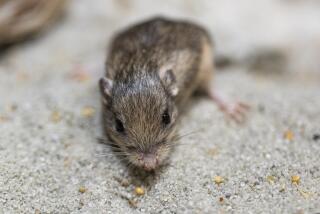A Mouse for the Ages
- Share via
While humans have formed an international coalition with cats to exterminate mice with poisons, traps and claws, some researchers in Michigan are developing new strains of tiny rodents with superior longevity. Hmmm. As millions seek to make the critters dead or dinner, University of Michigan scientists want these fecund cousins of Mickey to live long. Recently, they celebrated one mighty mouse’s birthday.
Yes, yes, it has been a long winter in Michigan and things weren’t helped by that Rose Bowl loss to a certain university in the southern part of California. But what’s up in Ann Arbor? When things don’t make sense these days, the first suspicion should always be that someone is playing with genes and cells again. Sure enough, Dr. Richard A. Miller and his team at the University of Michigan Medical School are trying to ascertain how hormones and genes affect aging.
A little less of this and some more of that could slow the inevitable aging process. Too late for Ponce de Leon or Joan Rivers, but if researchers live long enough, their lessons might help humans. People could have longer lives not getting by on Social Security to hunt longer-living mice. Then watch, a quick chemical company will invent a pill that speeds aging, causing senility even before puberty, which some parents of teens have long suspected were linked.
Using wild mice involuntarily recruited from Idaho, Miller has bred a strain of dwarf mice by genetic modifications that affect pituitary and thyroid glands and reduce insulin production. This is causing unusually long lives in micedom, where Medicare once came at age 1 and reaching 2 years could get you on the centennial segment of the “Today” show. Lab staff recently celebrated the fourth birthday of Yoda, the oldest known mouse he is thought to be. That’s far younger than the “Star Wars” saga sage. But for mice, four equals about 136 in human years, according to Miller, who at 54 would be a Methuselah mouse.
They’re tiny little fellows, these dwarf mice, about one-third the size of the ones whose panicked scurrying sends immense humans screaming from a room. They’re so small, in fact, that each dwarf lab mouse needs a full-sized cage buddy to stay warm and survive at night. Yoda’s companion is named Princess Leia. Except for being lifted up for doctor visits, neither mouse gets out much anymore, preferring to spend their silver months quietly shunning the lab rest home’s card games, happy hours and hall walks for predictable days of eating and sleeping followed by nights of the same.
All better, however, than being d-Conned at any age.




